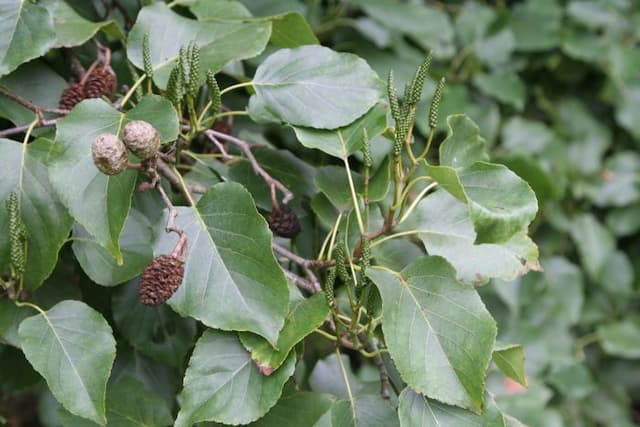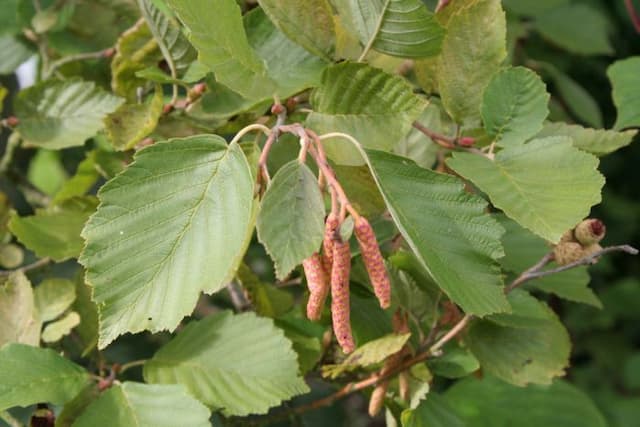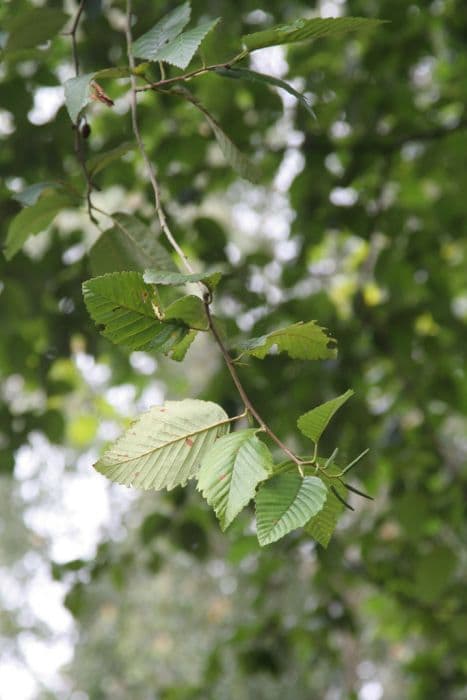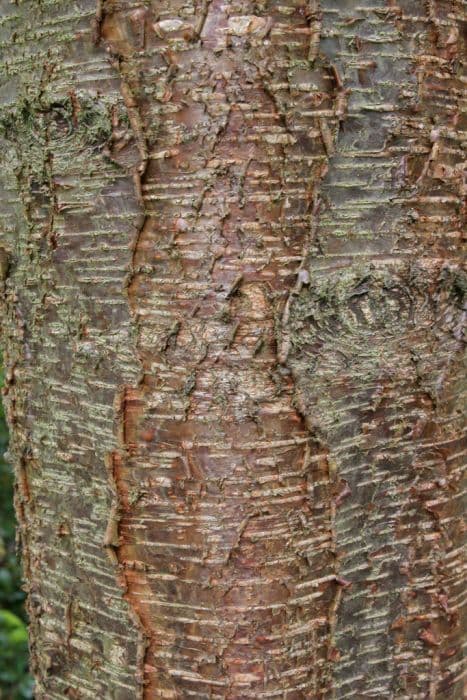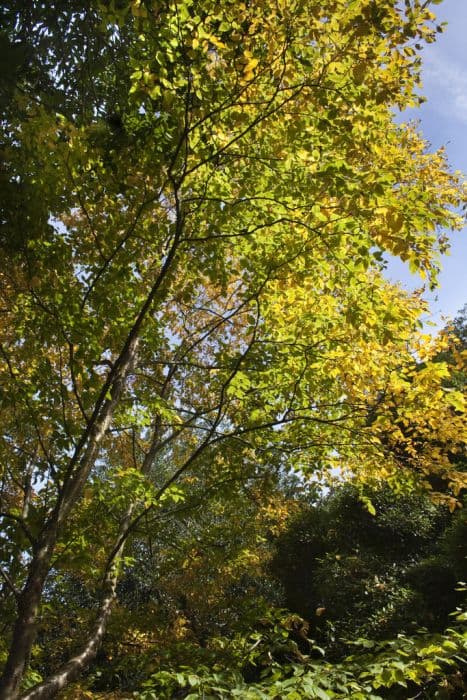Imperial Alder Alnus glutinosa 'Imperialis'

ABOUT
The plant known as European Alder 'Imperialis' has a distinctive appearance marked by its ornamental, deeply cut leaves that create a lacy texture. These leaves are sticky to the touch when they unfurl. The foliage is a rich green color during the growing season and turns to a yellow hue before falling off in the autumn. This variety does not typically produce flowers or cones as prominently as other relatives. The bark of the tree is grey and develops fissures as it matures, giving it a rugged appearance. It is often prized for its unique leaf shape and adds an elegant yet robust character to landscapes.
About this plant
 Names
NamesFamily
Betulaceae
Synonyms
Imperial Black Alder, Cut-Leaved Alder
Common names
Alnus glutinosa 'Imperialis'.
 Toxicity
ToxicityTo humans
Alnus glutinosa, commonly known as the European alder, is not known to be toxic to humans. There are no common symptoms of poisoning associated with this plant since it does not contain toxic compounds that are harmful to humans when ingested. Therefore, ingestion of parts of the European alder tree should not pose any significant health risks.
To pets
The European alder is not recognized as a toxic plant to pets. It does not contain substances that are known to be poisonous to animals if ingested. Consequently, ingestion of any part of the European alder tree is not typically associated with any symptoms of poisoning or adverse health consequences in pets.
 Characteristics
CharacteristicsLife cycle
Perennials
Foliage type
Deciduous
Color of leaves
Green
Height
40 feet (12 meters)
Spread
25 feet (7.6 meters)
Plant type
Tree
Hardiness zones
5
Native area
Europe
Benefits
 General Benefits
General Benefits- Erosion Control: The robust root system of Alnus glutinosa 'Imperialis' helps stabilize riverbanks and prevents soil erosion.
- Wildlife Habitat: Provides food and shelter for a variety of birds and insects, supporting biodiversity.
- Nitrogen Fixation: Improves soil fertility by fixing atmospheric nitrogen through a symbiosis with bacteria in root nodules.
- Landscape Aesthetics: Known for its decorative cut leaves, offering visual interest in landscaping and garden design.
- Tolerant of Wet Soils: Can thrive in wet and waterlogged conditions where other plants might struggle.
- Windbreak: Can act as a windbreak when planted in rows, providing shelter and reducing wind speed.
- Fast Growth: Often used for reforestation and land reclamation projects due to its rapid growth rate.
- Coppicing Ability: Can be periodically cut back to a stump, allowing for regrowth and sustainable wood production.
 Medical Properties
Medical Properties- Anti-inflammatory: The bark of Alnus glutinosa has traditionally been used for its anti-inflammatory properties.
- Astringent: The astringent qualities of Alnus glutinosa's bark have been applied to treat various skin conditions and as a mouthwash for throat infections.
- Diuretic: Alnus glutinosa has been considered to have mild diuretic effects.
- Antipyretic: The plant has been used to reduce fever.
- Wound healing: The extracts from the plant are known to promote wound healing and have been used for this purpose.
 Air-purifying Qualities
Air-purifying QualitiesThis plant is not specifically known for air purifying qualities.
 Other Uses
Other Uses- The wood of Alnus glutinosa 'Imperialis' can be used in the production of electric guitars for its tonal qualities, giving a warm and rich sound.
- In woodworking, the light yet durable wood is ideal for creating detailed mouldings and turned objects like bowls or spindles.
- The bark of this tree has traditionally been used in tanning leather, providing the tannins necessary for the process.
- As a natural dye, the catkins of Alnus glutinosa 'Imperialis' can be used to achieve green and brown hues in textiles.
- This tree can be incorporated in garden design as a structural element due to its distinctive deeply cut leaves and growth habit.
- Alnus glutinosa 'Imperialis' is planted on riverbanks to help prevent soil erosion with its robust root system.
- In rural crafts, the wood can be used to make rustic furniture or garden structures like trellises and pergolas.
- Its fibrous roots are sometimes used in basket weaving, providing a natural and durable material for traditional crafters.
- The tree can serve as a host for truffle cultivation, as certain truffle species associate with alder roots for nutrients.
- Alnus glutinosa 'Imperialis' sawdust and chips can be used for smoking fish and meats, imparting a unique flavor to the food.
Interesting Facts
 Feng Shui
Feng ShuiThe European Alder is not used in Feng Shui practice.
 Zodiac Sign Compitability
Zodiac Sign CompitabilityThe European Alder is not used in astrology practice.
 Plant Symbolism
Plant Symbolism- Resilience: The common alder is known for its ability to thrive in difficult conditions, especially in waterlogged soils, symbolizing the ability to endure and adapt to challenging situations.
- Protection: Alders have been traditionally considered as protective trees, believed to guard against malevolent spirits. This symbol of protection is often associated with the tree's historic use in foundation pilings in wetlands.
- New Beginnings: As a tree that is one of the first to colonize disturbed areas, the alder represents new starts and pioneering growth, often symbolizing the beginning of a journey or a new phase in life.
- Prophecy and Insight: In some folklore, the alder is linked to clairvoyance and spiritual insight, suggesting a deep connection with the inner self or the metaphysical world.
- Strength and Courage: The wood of the alder is strong and durable when wet, symbolizing inner strength and the courage to face life's difficulties with resilience.
 Water
WaterThe Imperial Black Alder should be watered regularly, especially during dry periods, to keep its soil moist but not waterlogged. Young trees benefit from about 15-20 gallons of water once a week, while established trees may require this amount every two to three weeks, depending on the weather and soil conditions. It's essential to water deeply and thoroughly to encourage root growth. During the winter, watering can be reduced as the tree will require less moisture due to slower growth and cooler temperatures.
 Light
LightThe Imperial Black Alder thrives in full sun to part shade. It prefers a location where it can receive at least four to six hours of direct sunlight each day, although it can tolerate light shade. The best spot for this tree is an open area where it can receive ample sunlight throughout the day, without being shaded by buildings or other larger trees.
 Temperature
TemperatureThe Imperial Black Alder is a hardy plant that can withstand temperatures as low as -20°F and as high as 90°F, making it suitable for a range of climates. However, the ideal temperature conditions for this tree are between 50°F and 70°F. It can adapt to temperature fluctuations but sudden extreme changes can be stressful for the tree.
 Pruning
PruningPruning the Imperial Black Alder is often done to remove damaged or diseased branches, improve its shape, and encourage healthy growth. It's best to prune in late winter or early spring before new growth begins. Prune sparingly, as heavy cutting back can lead to excessive sprouting. The removal of any crossing or rubbing branches should also be a part of the pruning process to maintain good air circulation and tree structure.
 Cleaning
CleaningAs needed
 Soil
SoilThe Black Alder 'Imperialis' thrives best in moist, well-draining soil with a high organic content. The soil pH suitable for this variety is slightly acidic to neutral, ranging from 5.5 to 7.0. An ideal soil mix can be made by combining loamy soil with peat and compost to enhance fertility and moisture retention.
 Repotting
RepottingThe Black Alder 'Imperialis', being a large tree, is not typically repotted. It is planted directly in the landscape where it can grow to full size. However, if initially grown in a container, repotting is done when the tree is young and its roots fill the pot, usually every 2 to 3 years.
 Humidity & Misting
Humidity & MistingThe Black Alder 'Imperialis' is tolerant of a wide range of humidity levels and does not require specific humidity conditions. It naturally grows near wetlands and rivers, indicating a preference for higher humidity environments, but it adapts well to average outdoor humidity levels.
 Suitable locations
Suitable locationsIndoor
Growing Black Alder 'Imperialis' indoors is not practical due to its size.
Outdoor
Plant Black Alder 'Imperialis' in moist, well-drained soil in full sun.
Hardiness zone
4-7 USDA
 Life cycle
Life cycleThe Black Alder 'Imperialis' begins its life as a seed, requiring cold stratification to break dormancy and promote germination. Once the seeds sprout, they develop into seedlings with characteristic serrated leaves and a fast growth rate, preferring wet environments. As the plant matures, it develops into a small to medium-sized tree with a distinctive narrow and conical crown, along with the ornamental, deeply cut leaves of the 'Imperialis' cultivar. During spring, it produces catkins; the male catkins are long and yellow, while the females are small and red, leading to the production of cone-like fruits that contain the seeds. As a pioneer species, Black Alder 'Imperialis' also improves the soil by fixing nitrogen through a symbiotic relationship with the bacteria Frankia alni. The tree can live for several decades and, after its senescence, it completes its life cycle by leaving behind seeds that give rise to new plants.
 Propogation
PropogationPropogation time
Spring to Summer
Alnus glutinosa 'Imperialis', commonly known as the Imperial Black Alder, is most commonly propagated through seed collection and sowing. The ideal time for seed propagation is in the fall or early winter when the seeds mature. To propagate the Imperial Black Alder by seeds, one should collect the mature cones and allow them to dry so they release the seeds. Once collected, the seeds should be sown in well-draining soil and lightly covered with soil or sand. It's important to keep the soil consistently moist until germination occurs, which can take several weeks to a few months. Seedlings can then be transplanted into individual pots or directly into their desired location in the landscape once they are large enough to handle.
